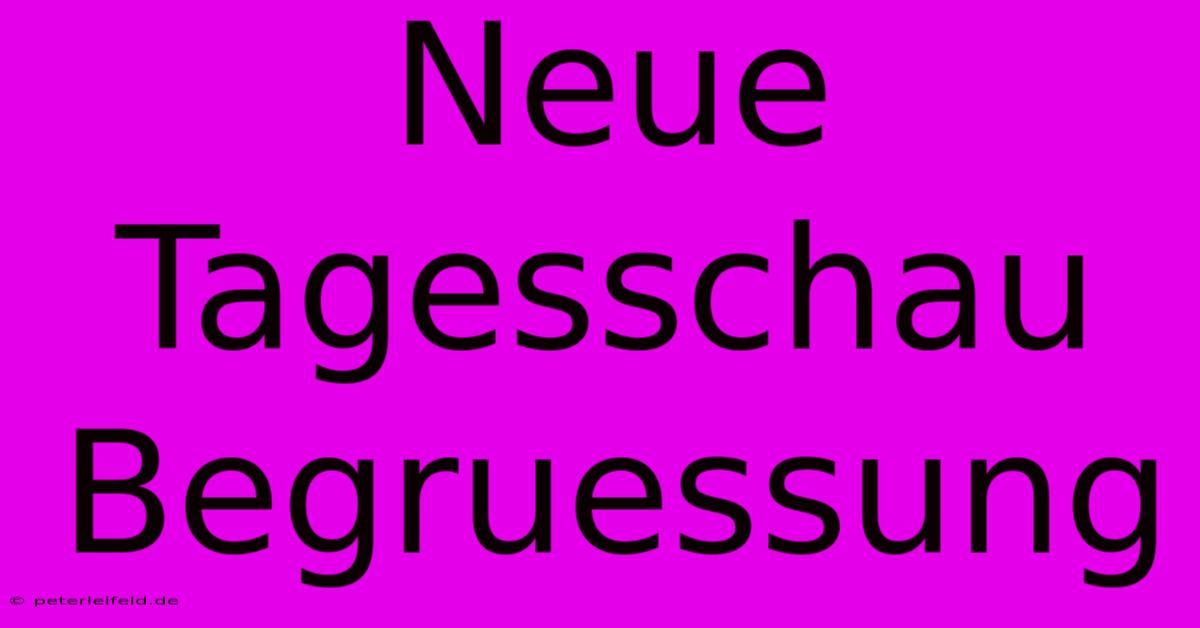Neue Tagesschau Begruessung

Discover more detailed and exciting information on our website. Click the link below to start your adventure: Visit Best Website Neue Tagesschau Begruessung. Don't miss out!
Table of Contents
Neue Tagesschau Begrüßung: Mehr als nur ein "Guten Abend!"
Hey everyone! So, you wanna know about the Tagesschau intro? I get it. It's more than just a simple "Guten Abend!" It's a ritual, you know? Like that comforting cup of tea before bed, or the familiar jingle of your favorite song. It’s part of the German cultural fabric, man.
I'll admit, I used to totally underestimate the Tagesschau intro. I mean, how hard can it be, right? Say "Guten Abend," smile, and bam! Done. Wrong. So wrong. I learned this the hard way.
My Epic Fail with the Tagesschau Intro (and What I Learned)
I was working on a documentary about German television history, and this seemingly straightforward intro became a massive rabbit hole. I thought I could just grab some quick footage and move on. Nope. Turns out, there's a whole science behind it. The subtle shifts in tone, the way the presenters stand, even the lighting – it's all meticulously planned.
I initially focused on just the greetings – the different ways they say "Guten Abend," "Guten Tag," or even "Guten Morgen" depending on the time slot. I was missing the big picture! I spent hours transcribing greetings, comparing different presenters, and even analyzing the slight variations in their pronunciation! It was exhausting, but super interesting. I ended up with spreadsheets full of data, and let me tell you, analyzing intonation patterns isn't exactly glamorous. I felt like I was studying a foreign language, which, in a way, I guess I was – the language of news broadcasting.
The sheer effort involved – analyzing the cadence, researching the history, checking the specific timing of the music – was a huge learning curve.
Key Takeaways: The Unsung Heroes of the Tagesschau Intro
My experience taught me a few things:
- It's about more than just words: The Tagesschau greeting is about establishing trust and authority. It sets the tone for the whole broadcast. Think about it: it's the first thing viewers see, and it unconsciously impacts how they perceive the news that follows.
- Consistency is key: The intro is remarkably consistent over the years. The visual identity has changed, sure, but the underlying message of authority and impartiality remains the same. It’s impressive, you know? This is important from a branding perspective. They're building trust over decades.
- Subtlety matters: The small details – a slight nod, a specific hand gesture, or even the angle of the camera – all contribute to the overall effect. These aren’t accidents; these are intentional decisions. This takes planning.
- Research is vital: Don't underestimate the amount of research involved in understanding the nuance of something like this. For my documentary, I had to delve into archival footage, interview former presenters, and analyze countless broadcasts. And even then, I felt I only scratched the surface!
Beyond the "Guten Abend!": Exploring the Tagesschau Intro Further
So what's the bottom line? The Tagesschau greeting is far more than just a simple phrase. It's a carefully constructed element that's integral to the broadcast’s overall success. It's a symbol of reliability and professionalism – a promise of accurate, unbiased reporting. It's a fascinating blend of careful planning and intuitive execution. This little "Guten Abend!" carries a ton of weight.
And now, after my own epic struggle to understand it – I really appreciate the artistry behind it all. Don't underestimate the little things! They can make all the difference.
Next time you watch the Tagesschau, maybe you'll notice a few things I missed initially. You'll look at that “Guten Abend!” a little differently, eh?

Thank you for visiting our website wich cover about Neue Tagesschau Begruessung. We hope the information provided has been useful to you. Feel free to contact us if you have any questions or need further assistance. See you next time and dont miss to bookmark.
Featured Posts
-
Vaporizer Black Week Angebote Check
Nov 30, 2024
-
Wasserstofftechnologie Nel Ballard Plug Power
Nov 30, 2024
-
Fussballspiel Sieg Und Verletzung Ache
Nov 30, 2024
-
Ingolstadt Arminia Spielbericht Und Tabellenplatz
Nov 30, 2024
-
Alle Gamestop Laeden Schliessen 500 Jobs Verloren
Nov 30, 2024
